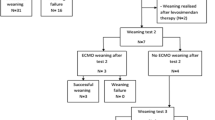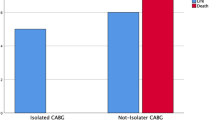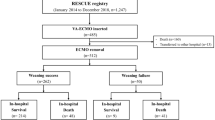Abstract
Mechanical circulatory support systems for the treatment of end-stage heart failure are now available for a wide variety of clinical situations and support times. Extracorporeal membrane oxygenation and centrifugal pump circuits have been most widely used in children, particularly in small infants. These systems are preferred for support after cardiac operations and for use in patients who have concomitant respiratory failure, but are suitable for short-term application only and intensive care is obligatory. True ventricular assist devices (VADs) qualify for long-term application and allow patients full mobilization. These features are important in patients awaiting heart transplantation as well as in those with myocarditis and cardiomyopathy, who might achieve complete cardiac recovery. Pneumatic pulsatile VADs have been available in pediatric sizes since 1992. At our institution, VAD use lasting from several days to 14 months in 70 infants and children with myocarditis and cardiomyopathy has led to a notable rise in survival in the past 5 years. We have been able to discharge 78% of the infants under 1 year old. In this review we present current VAD experience in children in the light of improvements in decision making, device technology, implantation techniques, and in coagulation monitoring and anticoagulation.
Key Points
-
In life-threatening heart failure, treatment with ventricular assist devices is gaining an increasingly important role, even in small infants and children
-
For postoperative, short-term support or for combined heart and lung failure extracorporeal membrane oxygenation is the most widespread device
-
In cases of cardiomyopathy or myocarditis or if long-term bridging to recovery or transplantation is expected for other reasons, use of pneumatic pulsatile devices is the strategy of choice
-
Pulsatile ventricular assist devices provide additional time to restore organ function; extubation, mobilization and enteral nutrition are mostly successful and, if no spontaneous improvement occurs, the chances for transplantation have been increased
This is a preview of subscription content, access via your institution
Access options
Subscribe to this journal
Receive 12 print issues and online access
$209.00 per year
only $17.42 per issue
Buy this article
- Purchase on Springer Link
- Instant access to full article PDF
Prices may be subject to local taxes which are calculated during checkout




Similar content being viewed by others
References
Mehta U et al. (2000) Extracorporeal membrane oxygenation for cardiac support in pediatric patients. Am Surg 66: 879–886
del Nido PJ et al. (1994) Extracorporeal membrane oxygenation support as a bridge to pediatric heart transplantation. Circulation 90: II66–II69
Goldman AP et al. (2003) The waiting game: bridging to paediatric heart transplantation. Lancet 362: 1967–1970
Bartlett R et al. (1976) Extracorporeal membrane oxygenation (ECMO) cardiopulmonary support in infancy. Trans Am Soc Artif Intern Organs 22: 80–93
Bartlett RH et al. (1977) Extracorporeal membrane oxygenator support for cardiopulmonary failure: experience in 28 cases. J Thorac Cardiovasc Surg 73: 375–386
Bartlett RH (2005) Extracorporeal life support: history and new directions. Semin Perinatol 29: 2–7
Aharon AS et al. (2001) Extracorporeal membrane oxygenation in children after repair of congenital cardiac lesions. Ann Thorac Surg 72: 2095–2101
Black MD et al. (1995) Determinants of success in pediatric cardiac patients undergoing extracorporeal membrane oxygenation. Ann Thorac Surg 60: 133–138
Conrad SA et al. (2005) Extracorporeal Life Support Registry Report 2004. ASAIO J 51: 4–10
Thuys CA et al. (1998) Centrifugal ventricular assist in children under 6 kg. Eur J Cardiothorac Surg 13: 130–134
Karl TR (1997) Circulatory support in children. In Mechanical Circulatory Support, 7–20 (Eds Hetzer R et al.) Berlin: Springer
Karl TR et al. (1991) Centrifugal pump left heart assist in pediatric cardiac operations. Indication, technique, and results. J Thorac Cardiovasc Surg 102: 624–630
del Nido PJ et al. (1999) Left ventricular assist device improves survival in children with left ventricular dysfunction after repair of anomalous origin of the left coronary artery from the pulmonary artery. Ann Thorac Surg 67: 169–172
Farrell DM et al. (2001) Management of the ventricular assist device circuit for pediatric cardiac patients. In: Mechanical support for cardiac and respiratory failure in pediatric patients, 159–168 (Ed. Duncan BW) New York: Marcel Dekker
Drews TN et al. (2003) Outpatients on mechanical circulatory support. Ann Thorac Surg 75: 780–785
Rose EA et al. (2001) Long-term mechanical left ventricular assistance for end-stage heart failure. N Engl J Med 345: 1435–1443
Reinhartz O et al. (2001) Multicenter experience with the Thoratec ventricular assist device in children and adolescents. J Heart Lung Transplant 20: 439–448
Warnecke H et al. (1991) Mechanical left ventricular support as a bridge to cardiac transplantation in childhood. Eur J Cardiothorac Surg 5: 330–333
Morales DL et al. (2005) Lessons learned from the first application of the DeBakey VAD Child: an intracorporeal ventricular assist device for children. Heart Lung Transplant 24: 331–337
Stiller B et al. (2005) Pneumatic pulsatile ventricular assist devices in children under 1 year of age. Eur J Cardiothorac Surg 28: 234–239
Reinhartz O et al. (2002) Current clinical status of pulsatile pediatric circulatory support. ASAIO J 48: 455–459
Stiller B et al. (2002) Left ventricular assist device. N Engl J Med 13: 1023
Hetzer R et al. (1998) Circulatory support with pneumatic paracorporeal ventricular assist device in infants and children. Ann Thorac Surg 66: 1498–1506
Kaczmarek I et al. (2005) Mechanical circulatory support in infants and adults with the MEDOS/HIA assist device. Artif Organs 29: 857–860
Konertz WF (2001) Clinical applications in children of the Medos ventricular assist device. In. Mechanical support for cardiac and respiratory failure in pediatric patients, 269–285 (Ed. Duncan BW) New York: Marcel Dekker
Konertz W et al. (1997) Clinical experience with the MEDOS HIA-VAD system in infants and children: a preliminary report. Ann Thorac Surg 63: 1138–1144
Bae JO et al. (2005) Extracorporeal membrane oxygenation in pediatric cardiac transplantation. J Pediatr Surg 40: 1051–1056
Foley DS et al. (2002) A review of 100 patients transported on extracorporeal life support. ASAIO J 48: 612–619
Dalton HJ et al. (2005) Update on extracorporeal life support 2004. Semin Perinatol 29: 24–33
Duncan BW et al. (1999) Mechanical circulatory support in children with cardiac disease. J Thorac Cardiovasc Surg 117: 529–542
Ishino K et al. (1997) Circulatory support with paracorporeal pneumatic ventricular assist device (VAD) in infants and children. Eur J Cardiothorac Surg 11: 965–972
Stiller B et al. (2003) Heart transplantation in children after mechanical circulatory support with pulsatile pneumatic assist device. J Heart Lung Transplant 22: 1201–1208
Merkle F et al. (2003) Pulsatile mechanical cardiac assistance in pediatric patients with the Berlin heart ventricular assist device. J Extra Corpor Technol 35: 115–120
Stiller B et al. (1999) Children may survive severe myocarditis with prolonged use of biventricular assist devices. Heart 82: 237–240
Takano H and Nakatani T (1996) Ventricular assist systems: experience in Japan with Toyobo pump and Zeon pump. Ann Thorac Surg 61: 317–322
Ashton RC et al. (1995) Left ventricular assist device options in pediatric patients. ASAIO J 41: M277–M280
Daily BB et al. (1996) Pierce–Donachy pediatric VAD: progress in development. Ann Thorac Surg 61: 437–443
Throckmorton AL et al. (2002) Pediatric circulatory support systems. ASAIO J 48: 216–221
Hetzer R et al. (2004) First experiences with a novel magnetically suspended axial flow left ventricular assist device. Eur J Cardiothorac Surg 25: 964–970
Song X et al. (2003) Axial flow blood pumps. ASAIO J 49: 355–364
Potapov EV et al (2001) Transcranial detection of microembolic signals in patients with a novel nonpulsatile implantable LVAD. ASAIO J 47: 249–253
Dandel M et al. (2005) Long-term results in patients with idiopathic dilated cardiomyopathy after weaning from left ventricular assist devices. Circulation 112 (Suppl): I37–I45
Waldenberger FR (1997) Pathophysiological considerations concerning uni- and biventricular mechanical cardiac assist. Int J Artif Org 20: 684–691
Duncan BW et al. (2001) Mechanical circulatory support for the treatment of children with acute fulminant myocarditis. J Thorac Cardiovasc Surg 122: 440–448
Stiller B et al. (2004) Consumption of blood products during mechanical circulatory support in children: comparison between ECMO and a pulsatile ventricular assist device. Intensive Care Med 30: 1814–1820
Acknowledgements
We thank Ms A Gale, medical editor, for editorial assistance. Significant contributions to the surgery and intensive care of the children at the Deutsches Herzzentrum Berlin have been made by Y Weng, M Huebler, V Alexi-Meshkishvili, E Henning, F Kaufmann, W Böttcher, M Redlin and F Berger. Written consent for publication of the photograph in Figure 4 was obtained from the patient's parents.
Author information
Authors and Affiliations
Corresponding author
Ethics declarations
Competing interests
Roland Hetzer and Brigitte Stiller act as consultants to Berlin Heart AG, Berlin, Germany.
Rights and permissions
About this article
Cite this article
Hetzer, R., Stiller, B. Technology Insight: use of ventricular assist devices in children. Nat Rev Cardiol 3, 377–386 (2006). https://doi.org/10.1038/ncpcardio0575
Received:
Accepted:
Issue Date:
DOI: https://doi.org/10.1038/ncpcardio0575
This article is cited by
-
Complications in children with ventricular assist devices: systematic review and meta-analyses
Heart Failure Reviews (2022)



